That’s what I love about strength-based calisthenics training. You need practically nothing apart from the most bare minimum of equipment and you get some big returns on your time and sweat investment. Devotees of only the barbell or only the kettlebell will travel only as far as their cast iron weapon of choice will take them. And much respect to them, because their tool of choice is a fantastic one, no doubt. But the devotee of calisthenics training who hates gravity with such a burning passion that he’ll make his body defy its laws through the power of grit, determination, and head-to-toe coordination of flesh so eager to mutiny against this detestable theory…well, this one will travel as far as they want, because their weapon is on them at all times.
The worst excuse in the world is “I don’t have a gym membership so I can’t get fit.” Neither did any of your ancestors, and I’m pretty sure if you look through a family photo album you won’t see a bunch of wieners; you’ll see people who moved a lot, worked with their hands, and those who are still around probably still have a vice grip and stories of how much more work they used to do by 9 am than you do all day. Fitness isn’t confined to fern-laden mirrored paradises – far from it. It’s forged from sweat, determination, and consistency, and you don’t need a laminated pass for that, you just need a plan. I’ve got one for you.
I can’t give you the choice of some blue pill or red pill that will give you the answers to all of your delusions or let you live comfortably within them, so if you’re not at that stage, then none of what I say may ring true. If, however, you’ve started to see that maybe the vast international conspiracy of health clubs that make “fitness” easy so long as you’re willing to part with your money JUST MIGHT not have your best interests in mind, then walk my way.
Enter calisthenics. Often relegated to position of third-class citizen among strength training due to ignorance of its hidden power, bodyweight strength training is the secret to gymnasts’ brute strength and Greek physique. Old school iron legends knew it is well, which is why 500-poundbenchers like Pat Casey and Marvelous Marvin Eder did copious amounts of weighted dips and weighted chins instead of suiting up in spandex and lifting gloves, copying the latest workout in Muscle and Fitness, and then chugging twice the recommended dose of BCAAs and spending the rest of the day at the water cooler talking about fitness instead of accomplishing it. But I digress…
The better you can control your own naked self in free space, the faster you can improve your ability to control weights in free space. Even if you’re not after becoming a gymnast, getting a hold of how your body moves will pay off in dividends later so long as you make it a point to kick ass at a few key moves. And there are lots, so don’t make the n00b mistake of trying to do them all at once. Get good at a few first and then we’ll talk about how to go all the way later.
So what are these first few? The chin-up, dip, pistol, L-sit, and back bridge get my vote. Why? Because they’ll all build some freaky strength, some freaky flexibility, and can be regressed and progressed to fit your ability level. Not strong enough to do dips/chin-ups/pistols/L-sits/back bridges yet? Do pushups, bodyweight rows, assisted pistols, floor leg raises, and shoulder bridges. You’ll get there when you get there, but start where you are.
Here’s your meat and potatoes program. Three days a week, between 20 and 40 minutes with just the above exercises and a variant or two from time to time. You can manage, trust me.
Here’s what your training will look like:
Monday/Wednesday/Friday
You’ll be doing ladders of each exercise, and you’ll be doing them in pairs. Half of your session will be on one pairing and the other half will be on the second. You’ll do the full ladder of one exercise followed by the full ladder of the next exercise.
Pair 1 (10 – 20 minutes; see below for times/days)
A1) L-Sit chin-ups – 1,2,3,4,5
A2) Pistol squats – 1,2,3,4,5 (each leg)
Do as many quality ladders as you can in the time allotted and then immediately move on to the next pair.
Pair 2 (10 – 20 minutes)
B1) Dips (3 second pause at the bottom of each rep): 1,2,3,4,5
B2) Bridge pushups: 1,2,3,4,5
Take your shirt off and admire yourself in the mirror because once you finish your second pairing you’re done for the day. And you were gonna do that anyway.
At least one day a week add in some specialized variety (i.e. change how you do the exercise just slightly). Here’s an example:
Pair 1 (10 – 20 minutes)
A1) Pull-up (pronated grip) (hold for 3 seconds at the top) – 1,2,3,4,5
A1) Pistol (start from the bottom) – 1,2,3,4,5
Pair 2 (10 – 20 minutes)
B1) Dip with a leg raise (do the dip and at the top bring the legs up to an L-sit) – 1,2,3,4,5
B2) Bridge pushup with limb raises (lift an arm or leg at the top) – 1,2,3,4,5
I’ll leave it up to your discretion on what days you’ll vary things up. Don’t go crazy. Stick to one or two variations so you don’t constantly try to reinvent your workout and end up adding a preposterous amount of variation and a piddly amount of strength. If you’re not big on any variety at all, I’d still recommend throwing in an L-sit leg raise after each dip at least once a week, as it’s a fundamental straight-arm hold that will do some good for your scapular stability. I could make up a whole workout full of straight-arm scapular moves, but that will have to wait for another article, and only if you’re good, too.
Monday will be your medium day. Do 15 minutes of Pair 1 and 15 minutes of Pair 2 for a total of 30 minutes of practice.
Wednesday will be your light day. Do 10 minutes of Pair 1 and 10 minutes of Pair 2 for a total of 20 minutes of practice.
And Friday will be your hard day. Do 20 minutes of Pair 1 and 20 minutes of Pair 2 for a grand total of 40 minutes.
How do you progress? Easy – drop out one minute from each pair each week until you can’t race the clock with good form any longer. And if you’re saying to yourself “but I can do dips, pullups and pistols with no problem – this isn’t going to be a challenge for me,” then the answer is obvious: add weight until it’s tough. Could not be simpler, and it will work like a charm.
There you have it. Do this for a few weeks and see if your strength, muscle mass, flexibility, and coordination don’t improve. Spoiler alert: They will. And when they do, please drop me a line on my Facebook page Aleks “The Hebrew Hammer” Salkin. I’d love to hear about it.
Aleks Salkin is an StrongFirst-certified kettlebell instructor (SFG), StrongFirst-certified bodyweight Instructor (SFB), and Primal Move Fundamentals Instructor. He grew up scrawny, unathletic, weak, and goofy, until he was exposed to kettlebells and the teachings and methodology of Pavel in his early 20s. He is currently based out of Jerusalem, Israel and spends his time spreading the word of StrongFirst and calisthenics, and regularly writes about strength and health both on his website and as a guest author on other websites. Find him online at http://www.alekssalkin.com.
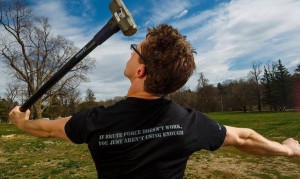
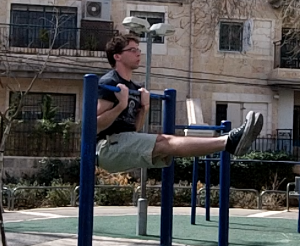
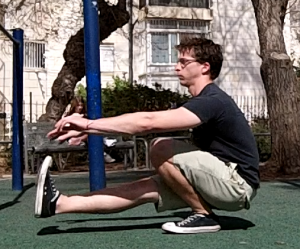
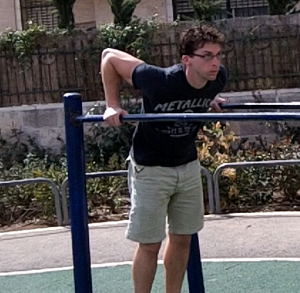
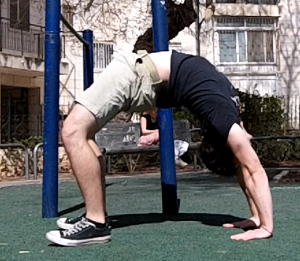
How did I miss this?!
Good stuff, Aleks! I’m partial to only doing BW exercises so this is something I will keep for a rainy day or a new program all together!